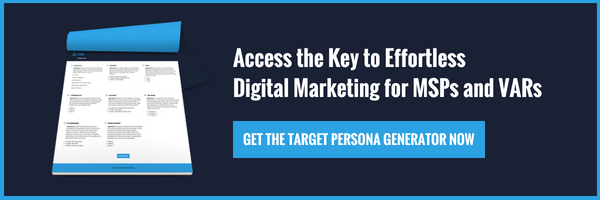For many MSPs market development funds (MDF) fuel the growth of their businesses. To attract vendors with generous MDF budgets, it’s important to have an existing brand that shows you’re a serious force to be reckoned with in your market. A key to create that brand awareness is to develop a steady stream of quality content.
Coming up with great blog articles, social media content, and content offers is difficult. We know. We’ll let you in on a little secret, MSPs who are steadily producing blogs, social posts, and beautiful graphics use a content calendar to guide their steps.
What’s a content calendar, you ask?
A content calendar is a simple spreadsheet listing out the content you’ll provide your audience, the platform you’ll design it for, and when you’ll send it out into the world for readers to consume.
That last part is the most important one. If you don’t have a deadline, most likely the content you’ve planned out will fall by the wayside. Beware of the “I’ll get to it next week” mentality that MSPs without MDF dollars often succumb to. Without a doubt, a content calendar is the second pillar in your digital marketing strategy empire. The first one is your Target Persona Report. You did use our handy Target Persona Generator, didn’t you? If not, grab yours here.
Another benefit to creating a content calendar is that it’s a tool to help you think strategically about your business. As you determine what’s most important to your ideal customer, you begin to think like that person. Creating a content calendar helps you do this. Here’s why:
It helps you answer questions such as:
- What should I create? As you’re thinking about what to cover, you have to start with the things that are most important to your target audience. This boils over into your internal company discussions about which services to offer, which ones to promote over the other, and how often to share information about those services with your audience.
- How often should I send it out? Your ideal customer may not want to receive information about the same topic every week, but rather only when they’re facing down a deadline. This is especially true if you’re serving heavily regulated industries such as healthcare and finance. Creating a content calendar helps you to think strategically about how often you’ll mention data center versus cloud computing topics, for instance.
- Where should I send what I create? A content calendar helps you focus on which digital platforms are the most relevant to your ideal customer. It helps you find answers to the questions, “Do my customers even read blogs or are they more interested in emails?” You can answer this question by distributing your content on multiple platforms and measuring which one gets the highest level of engagement from your readers.
As you seek the answers to these questions, you’ll have more clarity in your strategic development and sales strategy discussions. When you create, distribute, and measure content marketing for your business, you can use the response rates to certain blog topics and social posts to influence your decision making.
After all, if a post about disaster recovery gets 100 blog views but a post about pen testing gets 50, that may help you determine where to allocate funds during infrastructure investment budget discussions.
Now that you have more clarity on why content calendars are important, let’s take a look at the key components of this tool and why it’s critical to include certain elements while other are simply optional.
The Makings of a Low-Hassle, Highly Effective Content Calendar
We’re in the marketing industry so we’ve seen, and tried, some intricate content calendars. Out of all the ones we’ve created, the most effective have only a few attributes. Take a look and if you see a column or section that would make sense to add for your business, go for it.
Platform: Blog, Facebook, Twitter, LinkedIn – One of the first elements to include in your content calendar is the ‘where’ of it all. Meaning, have a section where you choose whether you’ll be creating a blog post or a Facebook, Twitter, or LinkedIn post. Knowing where your content will ‘live’ changes how you will create it so be sure to start with this column. Most content calendars lead with blogs as this platform is usually the center of a digital marketing strategy. A blog is really the place where you get to show your industry knowledge. When done well, you’ll create a dedicated following that looks forward to your communications.
For our more advanced readers: Instagram is good for business-to-business promotions. Take the long view and keep a close eye on B2B brands that are doing things well on Instagram. Hubspot comes to mind. Here’s a link to their Instagram account.
Topic: This can be difficult when you’re just starting out but if you’ve created a Target Persona it should be a breeze. A secret to making this process faster is to create topics around your current offerings and then expand over time to include topics you’ve seen your audience respond to over time.
Here’s what we mean: Let’s say your core offerings are network management, data security, disaster recovery, and cloud storage. Write one blog post on each of these topics and monitor the results of the posts after about a month to evaluate which topic is the most popular among your audience. You may wonder, how do I get my blog posts into the hands of my target audience? Good question. Here’s an article on email marketing and another one on paid social ads to help send traffic to your blog posts.
Frequency: This is a tough one for many MSPs and VARs, and it can stop brands from creating content when they realize, “I have to create a blog each week? How?” Another good question. At minimum, a weekly frequency helps create an aura of consistency around your brand. This is what top-flight MSPs are doing. Mimic their behavior and you’ll be seen as a solid candidate for MDF by vendors.
Side note: The design of your content factors greatly into creating an MDF-worthy image. We put together a guide for you on design best practices for MSPs and VARs here.
To make blog content creation easier:

- Be sure to have a solid writer on your team who can quickly and easily turn a phrase (based on their own expertise or by interviewing others who are experts in their field). Hint: Hire someone or outsource it, but this role is critical to consistent blog content creation and success.
-
Identify blog posts that resonate with you and mimic their style and format. This is very helpful to give a writer. To keep all of these articles in one place, use tools such as Evernote or Keep.
-
Set up alerts to receive news items about topics of interest. This helps with getting stats and trends affecting your ideal customer. Google News Alerts are great for this.
-
Create your content at least a week in advance of hitting the ‘send’ or ‘publish’ button. This takes pressure off of you if one week someone who is critical to the blog process is unavailable. With that one-week cushion, you’ll be less likely to miss that all-important weekly deadline. People really are watching and reading, and they will notice if you start, and then stop, your blog efforts. Consistency creates confidence in your brand among your ideal customers and vendors.
Call to Action (CTA): This is marketing-speak for “Do this so I know you’re interested in what I have to offer.” Bottom line: Determining what your CTA is in advance helps you move web visitors along the sales pipeline into the ‘lead’ category. This is the business-building portion of the content calendar,and it’s critical to profiting from your digital marketing efforts. Here’s an example of a CTA:

Those are the main elements of a content calendar but there are other things you can – and should – include, such as:
Target Persona – Most likely you target more than one type of person within an organization. As you build up your content marketing efforts, you’ll want to change the perspective of your blog content to speak directly to one type of ideal customer. For instance, you may want to write a blog post on topics of interest to CIOs one week and then present blog content for information directly affecting the work life of an IT Manager.
Content Cluster – You’ll also want to group your topics into clusters to ensure you’re truly covering the entire spectrum of information your audience craves. Network management, disaster recovery, and data security can be broad topics with vast subsets of information. Eventually, you’ll need to determine which subsets of these topics are most important and focus on them to ensure you’re not developing a one-note blog that only covers a small section of your product and service offerings.
How to Get Started With Your Content Calendar
Want to see what a top-flight content calendar should look like? We put one together for you. Download it here. [<–Include the excel spreadsheet download here. Instructions in the gray area above.] Use this as your guide to take your first steps in developing your content marketing efforts and watch your MSP or VAR business brand soar.
We know this can be a very involved process, even though we just presented a simplified version above. To do this well, you may need assistance. Let’s have a discussion about your content marketing and overall digital marketing strategy.